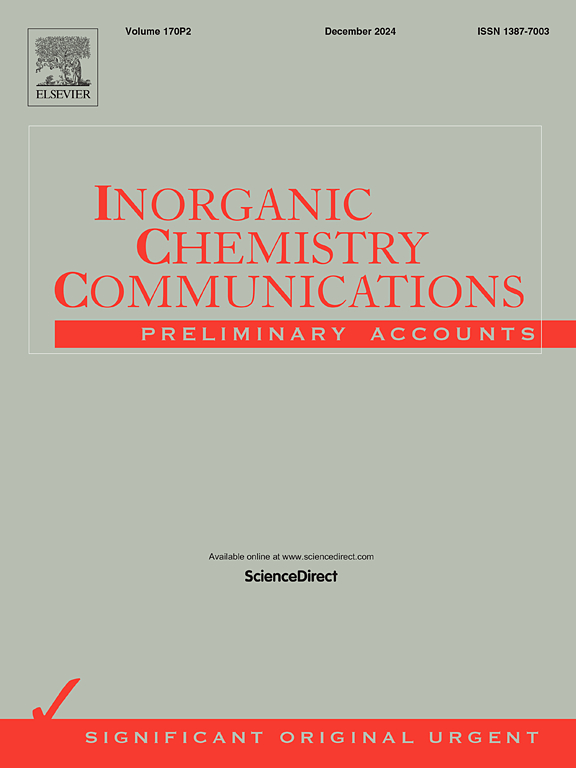2,5-Pyrazine dicarboxylic acid ligand bridged symmetrical dinuclear ruthenium(II) complexes: Synthesis, structure and spectroelectrochemical properties
IF 4.4
3区 化学
Q1 CHEMISTRY, INORGANIC & NUCLEAR
引用次数: 0
Abstract
The discovery of the pyrazine-bridged mixed-valent Creutz-Taube complex has triggered substantial focus on ligand-bridged symmetrical dinuclear ruthenium complexes to investigate intermetallic electronic coupling towards versatile applications. In this context, the synthesis, structure, electrochemical and spectroelectrochemical characterization of two redox-active symmetrical diruthenium complexes [(PPh3)2H(CO)Ru(μ-L)Ru(CO)H(PPh3)2] (1) and [(AsPh3)2H(CO)Ru(μ-L)Ru(CO)H(AsPh3)2] (2), (L = pzdca = 2,5-pyrazine dicarboxylate) was undertaken. Structural characterization unveils the presence of diruthenium units bridged by a bis-bidentately coordinated 2,5-pyrazine dicarboxylate ligand. Cyclic voltammetry, in conjunction with IR, EPR, and UV–Vis-NIR spectroelectrochemical studies, showed that complex 1 exhibited an irreversible oxidation, but a reversible one-electron reduction and that 1- could be studied by the given techniques, which revealed the expected bridging ligand-centred reduction process. Complex 1 had reversible electrochemical behaviour and witnessed the generation of a radical bridge [(PPh3)2H(CO)RuII(μ-pzdca●–)RuII(CO)H(PPh3)2].

2,5-吡嗪二羧酸配体桥接对称双核钌(II)配合物:合成、结构和光谱电化学性质
吡嗪桥接混合价Creutz-Taube配合物的发现引发了对配体桥接对称双核钌配合物的大量关注,以研究金属间电子耦合的多功能应用。在此背景下,研究了两种具有氧化还原活性的对称二钌配合物[(PPh3)2H(CO)Ru(μ-L)Ru(CO)H(PPh3)2](1)和[(AsPh3)2H(CO)Ru(μ-L)Ru(CO)H(AsPh3)2] (2) (L = pzdca = 2,5-吡嗪二羧酸盐)的合成、结构、电化学和光谱电化学表征。结构表征揭示了由双双齿配位2,5-吡嗪二羧酸配体桥接的二钌单元的存在。循环伏安法,结合IR, EPR和UV-Vis-NIR光谱电化学研究,表明配合物1表现出不可逆氧化,但可逆的单电子还原,并且1-可以通过给定的技术进行研究,这揭示了预期的桥接配体中心还原过程。配合物1具有可逆的电化学行为,并见证了自由基桥[(PPh3)2H(CO)RuII(μ-pzdca●-)RuII(CO)H(PPh3)2]的生成。
本文章由计算机程序翻译,如有差异,请以英文原文为准。
求助全文
约1分钟内获得全文
求助全文
来源期刊

Inorganic Chemistry Communications
化学-无机化学与核化学
CiteScore
5.50
自引率
7.90%
发文量
1013
审稿时长
53 days
期刊介绍:
Launched in January 1998, Inorganic Chemistry Communications is an international journal dedicated to the rapid publication of short communications in the major areas of inorganic, organometallic and supramolecular chemistry. Topics include synthetic and reaction chemistry, kinetics and mechanisms of reactions, bioinorganic chemistry, photochemistry and the use of metal and organometallic compounds in stoichiometric and catalytic synthesis or organic compounds.
 求助内容:
求助内容: 应助结果提醒方式:
应助结果提醒方式:


